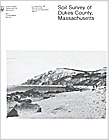The following map unit description is from the published "Soil Survey of Dukes County, Massachusetts"

Soil Survey of
Dukes County Massachusetts
The following map unit description is from the published "Soil
Survey of Dukes County, Massachusetts"

KaA-Katama sandy loam, 0 to 3 percent slopes. This soil is very deep, nearly level, and well drained. It is in broad areas in the southeastern corner of the town of Edgartown. The areas of this soil are irregular in shape and range from 10 to 200 acres. They make up about 1 percent of the survey area.
Typically, the surface layer is very dark grayish brown sandy loam 6 inches thick. The subsurface layer is dark brown sandy loam 3 inches thick. The subsoil is 17 inches thick. The upper 7 inches of the subsoil is dark yellowish brown sandy loam, and the lower 10 inches is light olive brown loamy coarse sand. The substratum is yellowish brown and strong brown coarse sand to a depth of 60 inches or more.
Included with this soil in mapping are small areas of Riverhead and Carxer soils that make up about 15 percent of the unit.
The permeability of this Katama soil is moderately rapid in the subsoil and rapid in the substratum. Available water capacity is moderate. The depth to seasonal high water table is more than 6 feet.
Many areas of this soil are in cropland. A few areas are used as homesites, and some areas are in native vegetation.
This soil is well suited to cultivated crops and to hay and pasture (fig. 11 }. Good tilth is easily maintained in cultivated areas, but the soil is droughty during periods of low rainfall. Incorporating crop residue into the soil and adding manure to the surface layer increase the organic matter content of the soil. The use of proper stocking rates, deferred grazing during wet periods, and rotational grazing help to maintain the desirable pasture plant species.
There are no major soil limitations for woodland management, but strong winds and salt spray severely hinder tree growth.
This soil is generally suitable as a site for buildings with or without basements. The soil in some areas does not adequately filter the effluent from septic tank absorption fields, causing a hazard of pollution to ground water. Low density housing reduces the volume of effluent, thus lessening the pollution hazard.
This soil is in capability subclass IIs.